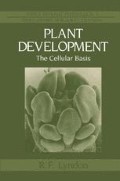Abstract
When the higher plant changes from vegetative to reproductive growth, a new set of structures, the flower, is formed and represents the expression of genes not previously expressed. The formation of sepals, petals, stamens, and carpels occurs nowhere else in the plant and meiosis occurs only in the stamens and carpels. The transition to flowering, therefore, represents a change in determination of the shoot apical cells and their derivatives. In a vegetative plant already competent to flower (ripe-to-flower), only a change in determination would be required. A lack of competence to flower is most clearly seen in those plants that show a juvenile phase, i.e. a phase in which it is not possible to cause flowering directly (see Ch. 10, section 10.3.5.2). Remembering that competence may be defined as the ability to develop along a particular pathway when given the appropriate signal, plants that flower in response to photoperiod, in which a signal is received from the leaves, may be regarded as competent to flower. In such plants, the leaves are obviously competent to form the floral stimulus, but they may not be in some juvenile plants. Furthermore, it is often far from clear whether this signal from the leaves first has to make the apical meristem competent to flower or whether the meristem is already competent to flower but simply lacks the signal for determination.
Access this chapter
Tax calculation will be finalised at checkout
Purchases are for personal use only
Preview
Unable to display preview. Download preview PDF.
Further Reading
Battey, N. H. & R. F. Lyndon 1990. Reversion of flowering. Botanical Review 56, (in press).
Bernier, G. 1988. The control of floral evocation and morphogenesis. Annual Review of Plant Physiology 39,175–219.
Bernier, G., J.-M. Kinet & R. M. Sachs 1981. The Physiology of Flowering, Vol. II. Boca Raton: CRC Press.
Francis, D. 1987. Effects of light on cell division in the shoot meristem during floral evocation. In Manipulation of Flowering, J. G. Atherton (ed.), 289–300. London: Butterworth. (Silene)
Kinet, J.-M., R. M. Sachs & G. Bernier 1985. The Physiology of Flowering, Vol. III. Boca Raton: CRC Press. (Growth substances and correlative growth in flowers)
McDaniel, C. N., S. R. Singer, J. S. Gebhardt & K. A. Dennin 1987. Floral determination: a critical process in meristem ontogeny. In Manipulation of Flowering, J. G. Atherton (ed.), 109–120. London: Butterworth.
Author information
Authors and Affiliations
Rights and permissions
Copyright information
© 1990 R. F. Lyndon
About this chapter
Cite this chapter
Lyndon, R.F. (1990). Competence and determination in flowering. In: Plant Development. Topics in Plant Physiology, vol 3. Springer, Dordrecht. https://doi.org/10.1007/978-94-011-6844-1_11
Download citation
DOI: https://doi.org/10.1007/978-94-011-6844-1_11
Publisher Name: Springer, Dordrecht
Print ISBN: 978-94-011-6846-5
Online ISBN: 978-94-011-6844-1
eBook Packages: Springer Book Archive

